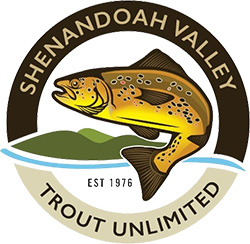What is AOP? Aquatic Organism Passage. It has been identified by local, state and federal governments that the ability of organisms, ie. fish, insects, reptiles, etc, to pass freely through the environment is critical for maintaining proper health of the ecosystem, as a whole. If organisms are not able to move about their habitats, as well as migrate, the organism suffers greatly, as does the entire ecosystem, because of the overall symbiotic relationship that each organism provides to its habitat in maintaining a balanced cycle of life. Limited movement of aquatic organisms has a far reaching negative impact to many species, directly and indirectly. As stewards of the vast outdoor resources present here in VA, it is our mission to assist in assessing these man made barriers, in order to facilitate the natural movement of aquatic organisms.
What efforts are being done to address the AOP needs? Across the country, and in particular, here in Virginia, Trout Unlimited, including our Shenandoah Valley TU Chapter, has partnered up with the VA Department of Wildlife Resources (DWR), which in turn is working with the US Forest Service (USFS), in addition to other government agencies, in order to identify and assess AOP obstructions, so that they can be corrected, based on priority. What this means is that all bridges, culverts and fords across the state need to be evaluated for AOP impact. This is no small undertaking, as a matter of fact, if you start to think about the magnitude of the issue, it becomes somewhat daunting! How do you perform an entire examination of an entire whale…one square inch at a time! With this approach in mind, the AOP initiative is being addressed in this same way. The state of VA is segmented by TU chapters which cover a designated geographical region. The SVTU chapter has a region that covers the South River watershed, as well as, the upper Calfpasture River, as a primary focus. In this area alone, thousands of bridges, culverts and fords have been identified that require a first hand, ‘boots on the ground’ assessment.
So how do AOP assessments get done? This is where it gets real, and fun at the same time. The USFS has a small dedicated staff that is responsible for the AOP assessment initiative here in VA. The state has way too many structures for this small staff to cover, but in addition to assessing structures for AOP impact, they train volunteers on how to properly perform an assessment. Once volunteers have been trained by the USFS to perform AOP assessments, they in turn, are allowed to, and are encouraged to, train additional volunteers in their area. This is a brilliant way to divide and conquer this Herculean task and it has proven to be an extremely efficient and effective approach. Additionally, our TU chapter is working closely with DWR in Verona to keep track of volunteer hours, as well as prioritize areas to be assessed. There is a massive TU effort behind the scenes call VA Priority Waters Areas (PWA) using Geographic Information Systems (GIS) that has plotted out watersheds and all the structures within them. This is an amazing to look at and a whole discussion in and of itself. So it turns out, you can take on a gargantuan effort by breaking it down into small, manageable tasks, provided you have a sound approach and cooperation across multiple entities.
So what happens next? AOP assessments are an ongoing effort that get organized and take place continuously. In our SVTU chapter we have trained volunteers that understand how to properly perform an AOP assessment. Training of additional volunteers consists of simply going out with a group and helping with assessments. The more you do, the better you get at understanding it. We typically go out in teams of 3-5 people and pick a prioritized area with 4-6 structures requiring assessment. Depending on the structure, it takes about 30 minutes to document an assessment. All documentation is done on anyone’s personal mobile phone via apps that have been provided and configured for the task. There is a small learning curve to get used to the terminology but the more assessments you do, the easier and faster it goes. The SVTU chapter and DWR have the required measuring tools needed. Once an assessment is completed, it gets uploaded to a centralized database where it is reviewed and scored for priority by trained professionals. If the priority is high enough, it gets put on a list for design, review and budget funding.
If you would like more information or would like to get involved, contact Tom Benzing,
Virginia Trout Stream Barrier Survey volunteer Resources
- Virginia’s Priority Waters areas (PWA) – link to VA TU Priority Waters initiative. A powerful way to see a map version of VA waters.
- Virginia Council TU Map Viewer – link to mapping tool to explore PWAs
- Southeast Aquatic Resources Partnership (SARP) websites: Lots of information and data about what is going on in our region
- Aquatic Barrier Inventory and Prioritization Tools – South East Region – link to mapping tool to explore barriers (dams and road-stream crossings); helpful in identifying which barriers have been surveyed and which ones remain to be done; links in tool to Google Maps for directions
- Southeastern Completed Surveys – link to mapping tool showing road-stream crossings with completed surveys including severity rankings; good for tracking progress and prioritizing which barriers to remove or replace.
- Virginia Wildlife Corridor Action Plan
- Virginia Wild Trout Management Plan
- DWR Volunteer Program – requires completed application to serve as volunteer; for submitting hours and mileage by registered VTSBS volunteers; tracks progress in completing barrier surveys in PWAs
